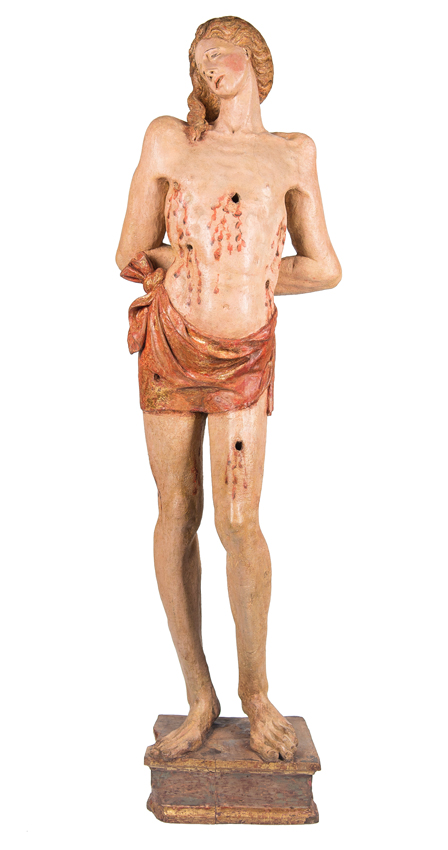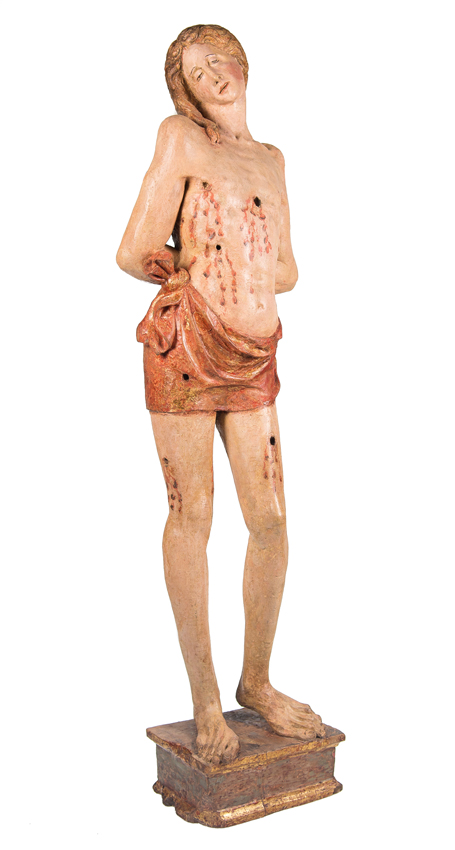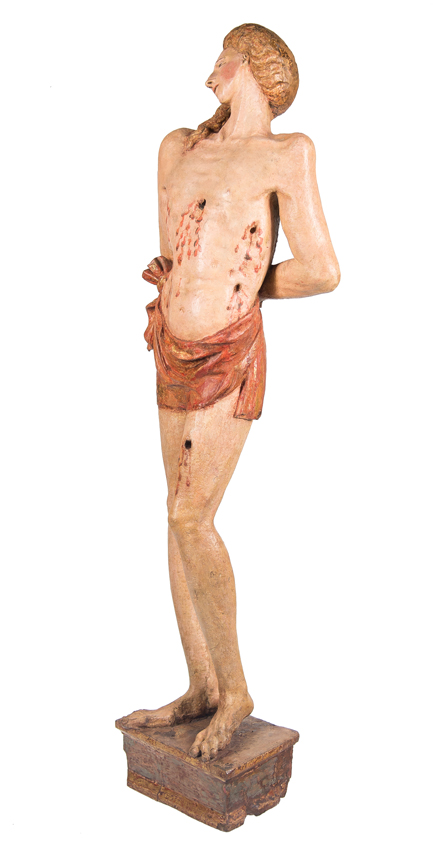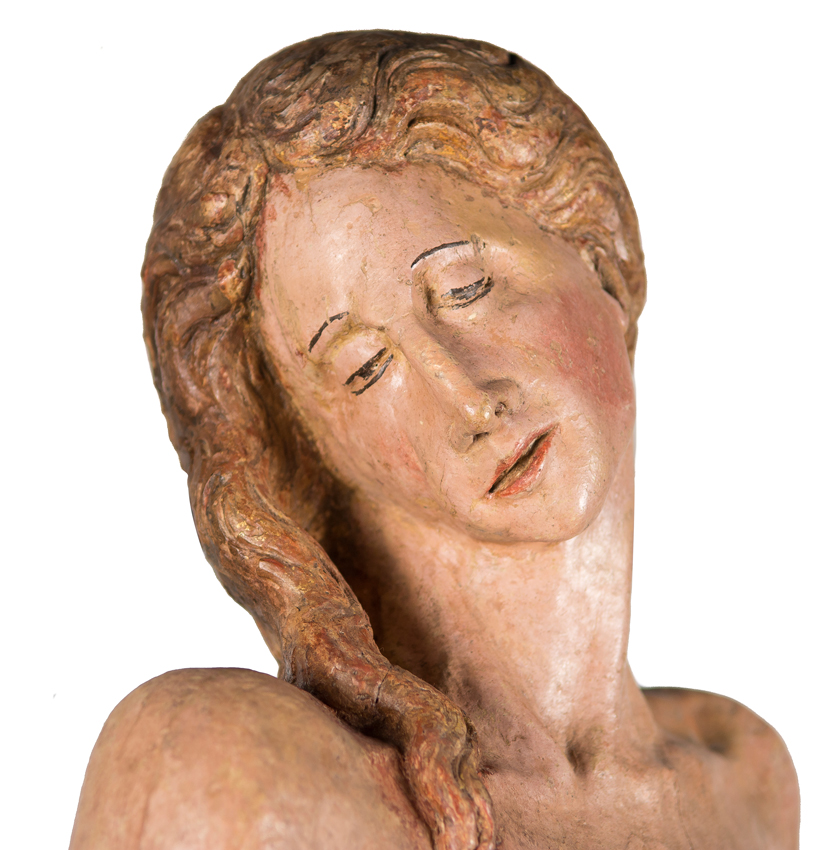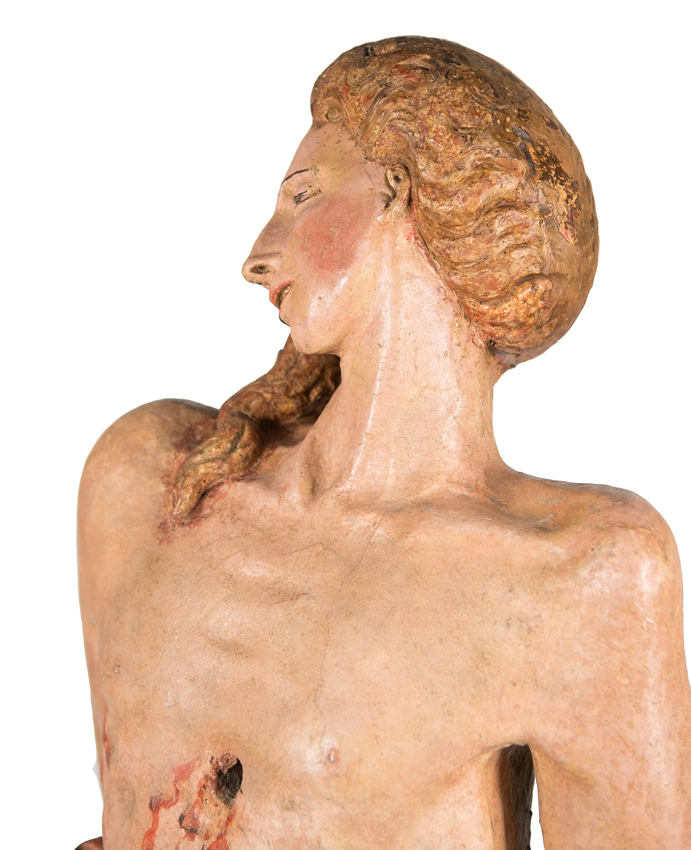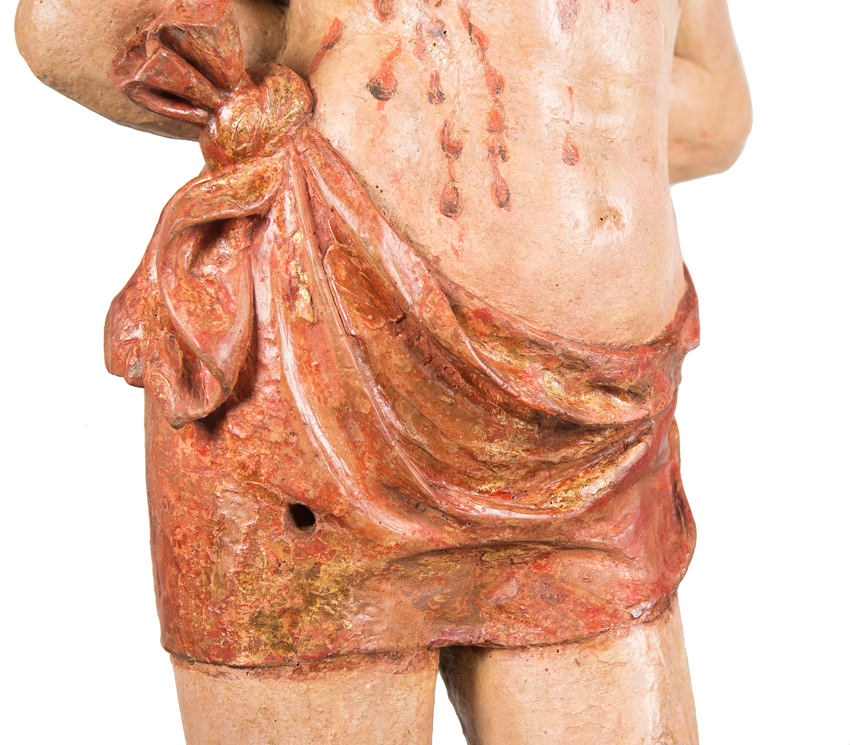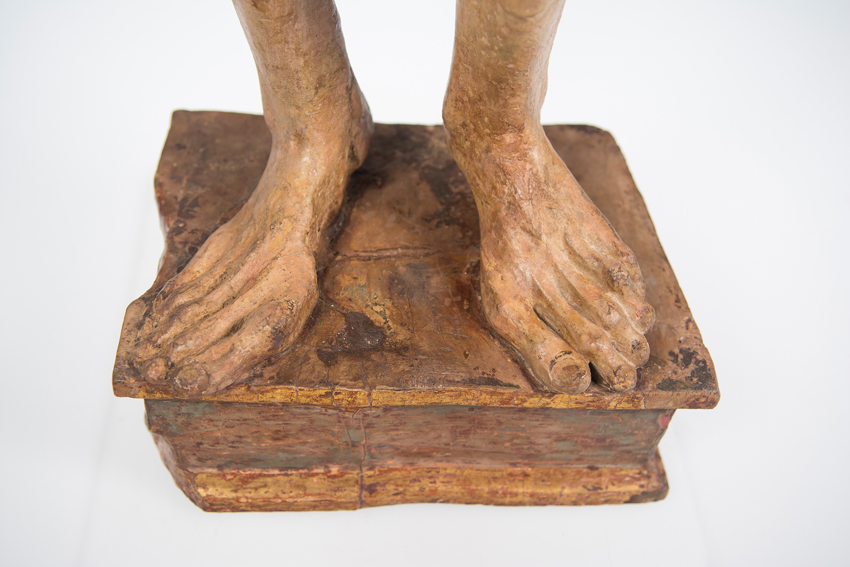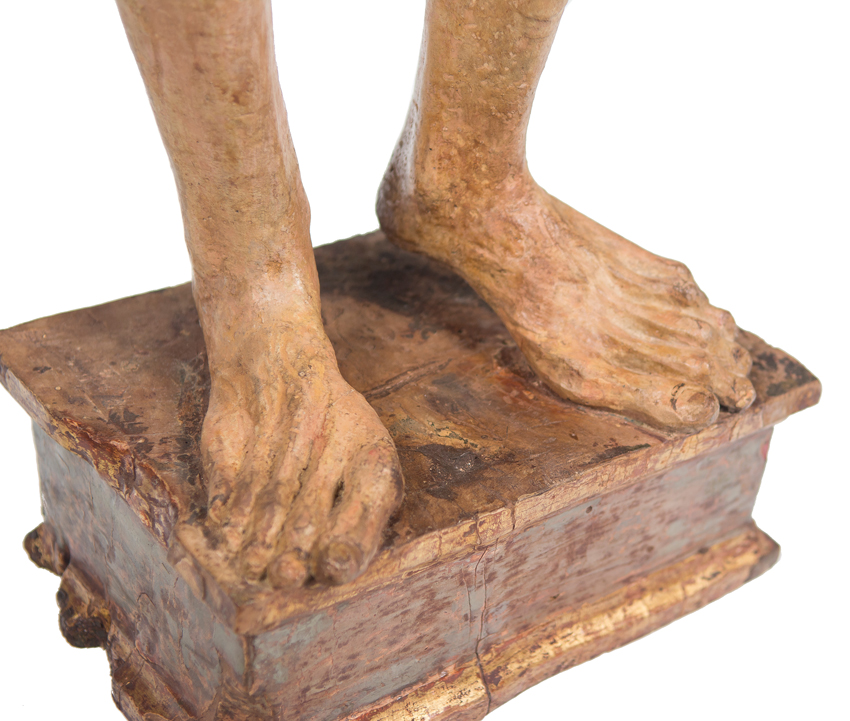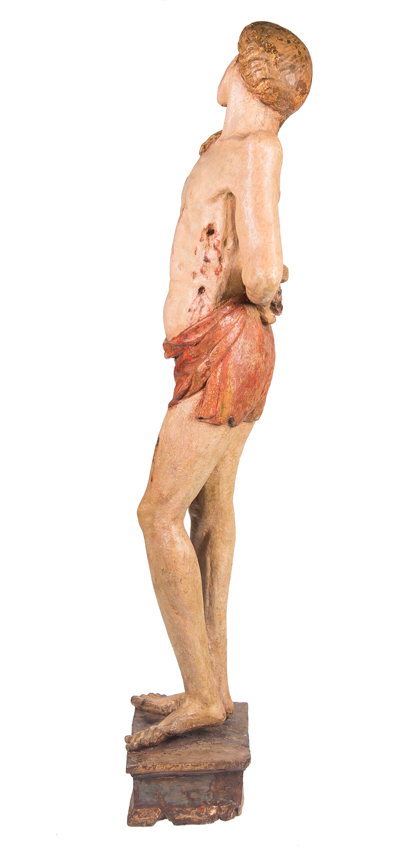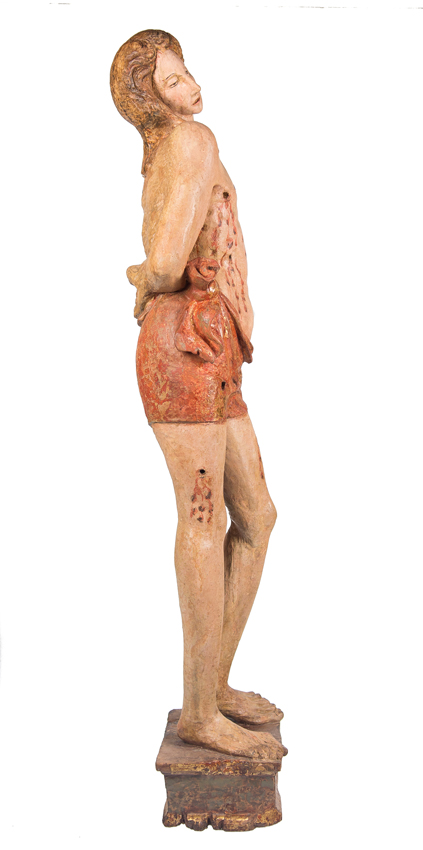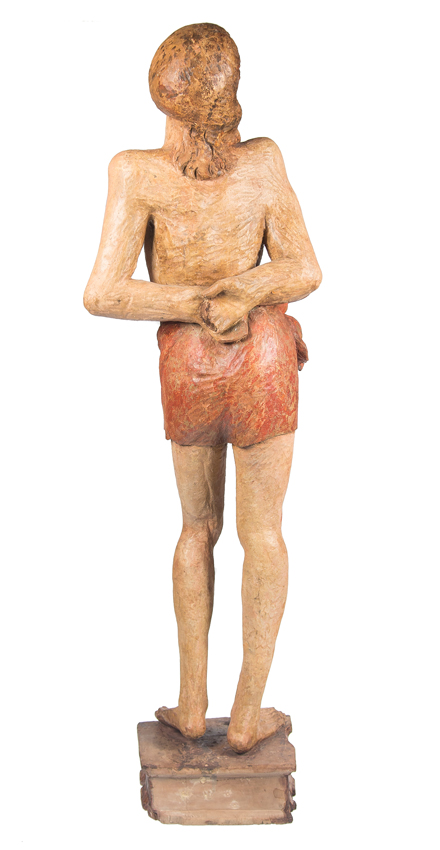14
Castillian School. Possibly Burgos. Renaissance. Circa 1530 - 1540.
Castillian School. Possibly Burgos. Renaissance. Circa 1530 - 1540.
"Saint Sebastian"
Carved and polychromed wooden sculpture.
122 x 38 x 21 cm
Saint Sebastian was one of the most celebrated saints during the Middle Ages, a popularity that continued into the Renaissance and the Baroque periods. It is not surprising that in most churches the saint is present, either as a sculpture or a painting. In the fantastic sculpture that we have here, the saint, a former Roman soldier, is shown in the most well-known episode of his hagiography: that of his martyrdom. Sebastian has been conceived by the anonymous sculptor with an extremely elongated canon and has been endowed with a certain idealised beauty, vaguely reminiscent of some creations of the ingenious Burgos Master, Diego de Siloe (ca. 1490-1563).
The piece is fully carved both on its front and back, although on the latter there are some small volumetric losses in the hands and hair. The plague-defying saint is depicted standing, with his legs in a slight contrapposto. The elongation of the limbs of his body, especially the legs, gives him remarkable elegance. He is completely pierced by arrows, with wounds on his legs, torso, and abdomen, although the arrows have disappeared, leaving only traces of blood flowing from the perforations they made. His hands are tied behind his back, so it appears as if he is pushing his torso forward. The prominent abdomen contrasts with the slender anatomy of his torso, in which the ribs and even the collarbones and shoulders can be discerned. The neck is extremely elongated and supports an oval head, elegantly tilted, and covered by a compact mane of hair from which one lock escapes, falling over the right shoulder. The face has delicate features: a prominent, sharp chin, a slightly open mouth with thin lips, a prominent nose with a straight profile, widely spread, half-open eyes, and curved eyebrows. The expression on the face is gentle and languid.
The nudity of his body is only veiled by the loincloth that covers his private parts and is decorated with various golden motifs, although some of them have been lost. The modelling of the cloth is smooth, as if glued to the body, and composed of curved folds. The bow or knot is located at the right hip.
The sculpture, which rests on a square pedestal, could be attributed to an anonymous master from Burgos, Spain, from the second quarter of the 16th century - perhaps between 1530-1540 - who may have been familiar with the work of Diego de Siloe, as indicated by the delicacy of execution combined with the slender canon. This elegance is not without a certain pathos, especially visible in the trunk and head.
We would like to thank Mr. Javier Baladrón, Doctor in Art History, for the identification and cataloguing of this sculpture.
Castillian School. Possibly Burgos. Renaissance. Circa 1530 - 1540.
"Saint Sebastian"
Carved and polychromed wooden sculpture.
122 x 38 x 21 cm
Saint Sebastian was one of the most celebrated saints during the Middle Ages, a popularity that continued into the Renaissance and the Baroque periods. It is not surprising that in most churches the saint is present, either as a sculpture or a painting. In the fantastic sculpture that we have here, the saint, a former Roman soldier, is shown in the most well-known episode of his hagiography: that of his martyrdom. Sebastian has been conceived by the anonymous sculptor with an extremely elongated canon and has been endowed with a certain idealised beauty, vaguely reminiscent of some creations of the ingenious Burgos Master, Diego de Siloe (ca. 1490-1563).
The piece is fully carved both on its front and back, although on the latter there are some small volumetric losses in the hands and hair. The plague-defying saint is depicted standing, with his legs in a slight contrapposto. The elongation of the limbs of his body, especially the legs, gives him remarkable elegance. He is completely pierced by arrows, with wounds on his legs, torso, and abdomen, although the arrows have disappeared, leaving only traces of blood flowing from the perforations they made. His hands are tied behind his back, so it appears as if he is pushing his torso forward. The prominent abdomen contrasts with the slender anatomy of his torso, in which the ribs and even the collarbones and shoulders can be discerned. The neck is extremely elongated and supports an oval head, elegantly tilted, and covered by a compact mane of hair from which one lock escapes, falling over the right shoulder. The face has delicate features: a prominent, sharp chin, a slightly open mouth with thin lips, a prominent nose with a straight profile, widely spread, half-open eyes, and curved eyebrows. The expression on the face is gentle and languid.
The nudity of his body is only veiled by the loincloth that covers his private parts and is decorated with various golden motifs, although some of them have been lost. The modelling of the cloth is smooth, as if glued to the body, and composed of curved folds. The bow or knot is located at the right hip.
The sculpture, which rests on a square pedestal, could be attributed to an anonymous master from Burgos, Spain, from the second quarter of the 16th century - perhaps between 1530-1540 - who may have been familiar with the work of Diego de Siloe, as indicated by the delicacy of execution combined with the slender canon. This elegance is not without a certain pathos, especially visible in the trunk and head.
We would like to thank Mr. Javier Baladrón, Doctor in Art History, for the identification and cataloguing of this sculpture.
Y nos dieron las 100...
Sale Date(s)
Lieu de la vente
General delivery information available from the auctioneer
The purchase price includes the delivery of the lots in the venue of the auction. Transporting to other destinations is at the own risk of the client. The customer must contact "LST", to give the corresponding instructions for such transporting. "LST" is not responsible for the packaging or any accident incurred during transportation.
Importantes Informations
This auction brings us to number 100!
On this special occasion, we present a careful selection of European and New Spanish works, including a previously unpublished painting by Luca Giordano, a magnificent private collection of medieval Spanish sculpture and wonderful examples of painting and sculpture from Spanish America art among other.
We hope you enjoy it as much as we did preparing it.
With our thanks to all those who have made it possible for us to get this far.
Conditions Générales de Ventes
CONDITIONS OF THE AUCTION:
I. REGISTRATION. To bid in the room customers must register at the beginning, filling out a form and picking a number that will identify them during the auction. Customers may be required to register in bank references or other guarantee system and if they do not prove the solvency "LST" will not accept bids and award the auction.
II. WRITTEN BIDS. "LST" will accept written bids, which will be formalized in the form provided by the room until the day before the auction. In such auctions, the room will bid in name of the client until the maximum stated in the offer and always at the lowest possible price. If there are two or more bids for the same amount, the one placed first will have the priority. Written bids received in advance, will have priority on the day of the auction.
III. TELEPHONE BIDS. "LST" will allow telephone bids, if interested people contact "LST" days before the auction providing personal data, ID card and the phone number which will be used by the staff of "LST" to call at the time of the auction. The buyer, within all the legal rights is making an offer for the asking price, when applies for telephone bid. "LST" will not take responsibility for any technical defects beyond its control, which may prevent to contact successfully the bidder during the auction.
IV. AUCTIONEER. The auction will be conducted by an auctioneer, director of the auction will be judge and arbitrator of it with full authority in its development, will award the lots to the highest bidder and is able to settle any controversy concerning lots sale, reject bids, divide lots or group them and remover objects from the room. Will be able to, if it is deemed suitable, not accept bids on the auction. His decision will be unappealable.
V. SALE OF LOTS. The lots are awarded to the highest bidder. Once the auctioneer blows the hammer, the buyer becomes responsible of the lot purchased, exempting "LST" of liability to for any damage and / or accidents that may occur. No refunds of lots.
VI. STARTING PRICE. The amount shown in the catalogue as the starting price for each lot will be, as a rule, the minimum selling price, except for exceptional cases where a reservation may be agreed upon with the seller or it set discretionary by the room.
VII. SCALE OF BIDS. The bids are set according to the following scale:
From 50.-€ to 200.-€…………………………………………..at 10.-€
From 200.-€ to 500.-€…………………………………… …25 in 25.-€
From 500.-€ to 1.000.-€………………………………..…..….50 in 50.-€
From 1.000.-€ to 2.000.-€………………………………..…100 in 100.-€
From 2.000.-€ to 5.000.-€……………………………….….250 in 250.-€
From 5.000.-€ to 10.000.-€…………………………………500 in 500.-€
From 10.000.-€ to 20.000.-€……………………………1.000 in 1.000.-€
From 20.000.-€ to 50.000.-€……………………………2.500 in 2.500.-€
From 50.000.-€ to 100.000.-€…………………………..5.000 in 5.000.-€
From 100.000.-€ to 100.000.-€………………………10.000 in 10.000.-€
From 200.000.-€ to 200.000.-€………………………25.000 in 25.000.-€
From 500.000.-€ to 500.000.-€………………………50.000 in 50.000.-€
VIII. RIGHT OF ADMISION. "LST" reserves the right to admission to the auction room and to reject, at its judgment, any purchase order, from clients whose solvency is not duly proved as well as not to sale auctions.
IX. SALE PRICES. The successful bidder of one or more lots must pay "LST" the final sale price achieves at auction, plus the 22 % plus 21% VAT on the commission, at total 26,62 % on Hammer Price.
X. CATALOG DATA. The catalogue data are obtained in order to careful research and advice, however, any responsibility is afforded about its accuracy. The lots will be auctioned in the state in which they are, not accepting any claims in restorations, breakage, damage, imperfections and, even description or numbering mistakes in the catalogue, in case of it, being the burden of the buyers to make sure before the auction that the description matches with their personal opinion about respective lot. The exhibition of the lots is intended to allow a perfect review and study of them.
XI. PAYMENT AND REMOVAL OF LOTS. Payment and removal of the lots will be held no later than five days following the auction. After this period expire without having the buyer removed the lot or lots purchases, it will accrue an expense of custody of 6 euros per day on each lot.
15 days after the auction without having the buyer paid and removes the sold lots, "LST" will inform the seller and there will begin judicial proceeding in order to obtain payment. The delay in payment by the purchaser of his/her sold lots will carry an interest increase at a rate of 1,5% per month.
XII. DELIVERY OF LOTS. The purchase price includes the delivery of the lots in the venue of the auction. Transporting to other destinations is at the own risk of the client. The customer must contact "LST", to give the corresponding instructions for such transporting. "LST" is not responsible for the packaging or any accident incurred during transportation.
XIII. RIGHT OF FIRT REFUSAL AND REPURCHASE. "LST" in order to article 38 of "Ley 16/1985 de 25 Junio del Patrimonio Histórico Español" (BOE. 155 June 29, 1985), will notify in advance to the Ministry of Culture, the content of their catalogues. Concerning the lots subject to the legislation referred to in the preceding paragraph, the Administration may exercise the rights of first refusal and repurchase according to the law. "LST" will watch over the protection of Artistic, Historical and Bibliographical Heritage of Spain. For customers out of European Community, a tax for export is required by the Administration.
XIV. VALUE ADDED TAX (I.V.A). This tax will be accrued on commissions of "LST" for buyers, using the rates prevailing on the date of the auction.
XV. DATA PROTECTION. In order to the "Ley 15/1999 de 13 de Diciembre, de Protección de Datos de Carácter Personal", the client authorize "LST", the inclusion of their data in a customer file, and for the promotion by "LST" of the objects at all times the rights of access, rectification or deletion of personal data by sending the appropriate request to the following address: LA SUITE SUBASTAS, C/ Conde Salvatierra, 8, 08006. Barcelona.
XVI. EXPRESS LEGAL JURISDICTION. These Conditions are governed by and interpreted in accordance with the rules of Spanish law. The mere act of participating in the auction as seller, buyer or bidder, implies acceptance of these Terms and Conditions.
Sales operations are understood to be held at the registered office of "LST", C/ Conde de Salvatierra, 8, 08006. Any dispute shall be taken to the competent courts of Barcelona, expressly waiving any other jurisdiction, in accordance with Article 55 of the "Ley de Enjuiciamiento Civil".


























